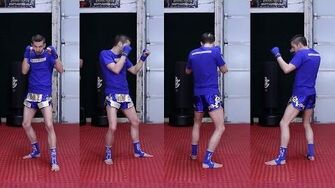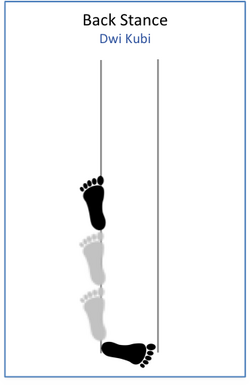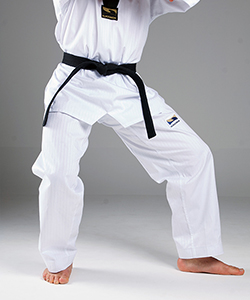No edit summary |
Tag: Source edit |
||
| (10 intermediate revisions by one other user not shown) | |||
| Line 1: | Line 1: | ||
| + | [[File:Back Stance Tutorial (Fighting Stance) Taekwondo for MMA & Kickboxing|thumb|right|335 px]] |
||
| ⚫ | The '''Back Stance''' ( |
||
| + | ::The following stance is called a '''Back Stance''' in [[WTF Taekwondo|WTF-style]] taekwondo and is called '''L Stance''' in [[ITF Taekwon-do|ITF-style ]] taekwondo. (In [[Tang Soo Do]] and some styles of [[Traditional Taekwondo]], it's sometimes called Fighting Stance.) |
||
| ⚫ | The '''Back Stance''' (''dwi kubi seogi'') is performed with the leading foot pointed directly forward, the rear foot perpendicular at a 90 degree angle from the front foot. (This is why it it sometimes called an L Stance, your two feet are placed like the letter L. See also, [[Left Stance]] and [[Right Stance]].) |
||
The front foot is about one stride (three foot lengths) in front of the rear foot, so that the heel of the front foot points back directly to the heel of the rear foot. Most of the weight (about two thirds) should be on the rear leg. Both legs are bent at the knees, and both feet are flat on the floor. |
The front foot is about one stride (three foot lengths) in front of the rear foot, so that the heel of the front foot points back directly to the heel of the rear foot. Most of the weight (about two thirds) should be on the rear leg. Both legs are bent at the knees, and both feet are flat on the floor. |
||
[[Image:Back_Stance.png|250px]] |
[[Image:Back_Stance.png|250px]] |
||
| − | [[ |
+ | [[Image:BackStance.jpg]] |
| + | {{Whiteline}} |
||
| + | == Naming the Back Stance == |
||
| ⚫ | |||
| + | |||
| + | blah blah blah |
||
| + | |||
| + | This can be confusing for some students, since for most other stances the "right" version of the stance means that the right foot is forward. For example in a right [[Front Stance | front stance]] the right foot would be forward. |
||
| + | |||
| ⚫ | |||
| + | *Back Stance on [http://www.taekwondopreschool.com/stances.html#backstance Taekwondo Preschool] |
||
*Stances on [http://www.theschoolofmartialarts.com/taekwondo/world-federation-style/techniques/stances/ School of Martial Arts] |
*Stances on [http://www.theschoolofmartialarts.com/taekwondo/world-federation-style/techniques/stances/ School of Martial Arts] |
||
*Stances on [http://www.martialyou.com/index.php/styles/shawn-hill-s-dojang/curriculum/31-taekwondo/131-taekwondo-stances Martial You] |
*Stances on [http://www.martialyou.com/index.php/styles/shawn-hill-s-dojang/curriculum/31-taekwondo/131-taekwondo-stances Martial You] |
||
| + | * {{YouTubeLookup|Back+Stance}} |
||
[[Category:Stance]] |
[[Category:Stance]] |
||
Revision as of 05:55, 26 November 2020

Back Stance Tutorial (Fighting Stance) Taekwondo for MMA & Kickboxing
- The following stance is called a Back Stance in WTF-style taekwondo and is called L Stance in ITF-style taekwondo. (In Tang Soo Do and some styles of Traditional Taekwondo, it's sometimes called Fighting Stance.)
The Back Stance (dwi kubi seogi) is performed with the leading foot pointed directly forward, the rear foot perpendicular at a 90 degree angle from the front foot. (This is why it it sometimes called an L Stance, your two feet are placed like the letter L. See also, Left Stance and Right Stance.)
The front foot is about one stride (three foot lengths) in front of the rear foot, so that the heel of the front foot points back directly to the heel of the rear foot. Most of the weight (about two thirds) should be on the rear leg. Both legs are bent at the knees, and both feet are flat on the floor.
Naming the Back Stance
blah blah blah
This can be confusing for some students, since for most other stances the "right" version of the stance means that the right foot is forward. For example in a right front stance the right foot would be forward.
References
- Back Stance on Taekwondo Preschool
- Stances on School of Martial Arts
- Stances on Martial You
- Watch Back+Stance videos on YouTube

